Genre: Fighting Developer: Copya System Ltd. Publisher: Asmik Corporation Players: 1-2 Released: 1990
During the late ’80s and early ’90, pro wrestling was probably at its peak of popularity. I’m not just speaking of the Americas here; on the other side of the Pacific, Japanese wrestlers became huge mega stars. Many of them, female athletes in particular, were pretty famous with the media, even taking the occasional acting role (though pretty much with the same amount of acting talent and success their U.S. counterparts had). Cutie Suzuki (who’s real name was Yumi Suzuki actually) was one of those wrestling mega stars who, despite never actually winning one of the major titles during her career (though she was JWP Junior Champion at some point), was probably at the peak of her popularity around 1990. Aside from taking the lead in three movies (two of which went direct-to-video) and voice acting in one anime, she also got her very own video game for the Sega Genesis: An all-female wrestling game, featuring her as the only real existing fighter. Since her popularity didn’t extend outside of Japan, the game was never brought stateside (or to Europe, for that matter). However, there might be the occasional wrestling enthusiast who might enjoy a game based simply on its gameplay (yeah, right), or some collector who might want to seek out oddities, wondering how such an exclusive niché title might play. So let’s dig into the review of Cutie Suzuki No Ringside Angel.
The oddities already begin with the cover. Ringside Angel is pretty much the only Genesis game I know of that sports a holographic variant cover. Depending which way you tilt the box, our feature protagonist either coquettishly wears a jeans jacket or poses in a typical “show me your biceps” bodybuilder pose. It is not without its charm, in a cheesy kind of way. You can kind of understand why her ringside name was “Cutie.” Other than that, the cover sports four-color anime profile pictures of the other female characters present in the game. Aside from the gimmick, the cover looks cheap and is a garish harbinger of things to come.
The game offers you the opportunity to fight as one out of eight characters. Cutie Suzuki is the only real fighter in the selection, though by the looks of it, the seven others seem to be at least based on existing athletes in the Japanese female wresting world, with such colorful names as “Helloween” or “Guns Oyama.” There are four gaming modes you can pick, though there is no tag team or Royal Rumble-type option. Each of the four selection plays basically the same. There’s a single-player mode, where you battle a long, long way through five different tournaments (fighting the same characters over and over again, though in a higher difficulty every time), player vs. player, player vs. computer-controlled opponent; and finally, AI vs. AI mode, where you pick two players and watch the computer duke it out (which might only be worthwhile if watching crudely drawn 16-bit renditions of female wrestlers is actually a thing for you).
The gameplay is… well, I wouldn’t say it’s horrendous. It’s basic and intuitive but far from good. The game utilizes the standard three-button Genesis controller, with A being used for punching, pinning, or vividly smashing during a grapple, and B for kicking or picking up an opponent lying on the floor. By skimming through the manual, I can see that there appears to be an abundance of moves (or rather move sets), that sometimes require multiple button presses or even the C button, most of which are situational (like climbing and jumping from the ringside corner, picking up the opponent from behind and slamming him on the floor, or the signature moves typical to wrestling games). However, the controls are rather sluggish and the characters move at a snail’s pace, so it’s very hard to determine when a particular button press actually causes a certain attack. So most of the times, matches turn into frenetic button-mashfests, where you hardly even see an actual response. Whenever you actually manage to pull off one of the signature moves, you are left wondering what you did to cause that effect, since these moves rarely seem to be reproducible at any given time. Image representations of the fighters at the top of the screen should give an idea which character has momentum and which is currently more under pressure. However, it hardly indicates how worn out an athlete actually is, and since there isn’t a time limit, a single match (especially between two human opponents capable of fast button-mashing) can drag out forever.
The graphics are not really worthy of a 16-bit console! As with the cover, there are a couple of nice little gimmicks to lighten up the atmosphere. You’ve got a referee in his typical white-and-black-striped clothing; there are two commentators who retell the on-screen events in speech bubbles (though only in Japanese); and whenever you win a tournament, a bitmap girl in a bunny suit arrives to award you with a trophy. Those are cute extras, but they fail to detract from the fact that the characters themselves lack detail. There are a fair amount to different animations, but they all share the same moves between them, and aside from the signature moves, the fighters could all be just simple palette swaps. You can differentiate most of the characters only by their hairstyle and the color of the swimsuit (which, in a failed attempt to be “sexy” shows of the fighters malformed calves and leaves one pixel uncovered to represent a navel, for all of those who find one grey pixel on a rose or brownish circle sexy). No shading and a very limited palette give the game more of an 8-bit vibe than anything.
The sound? Well, as with the graphics, it has its novelties, but overall it’s pretty bad. You can hear the referee talk whenever he counts down the pin, and the white noise you hear occasionally should probably represent cheers and whistles from the audience. Those are the better sound effects. The music is representative of some elevator-style muzak: some uninspired doodling that doesn’t excite nor incite. And the fight sounds themselves fall somewhere in between tenderizing a steak with a spoon and listening to a tumble dryer, with all the accompanying whooshes and slaps.
I heard someone say that this game was the Rumble Roses of its day. If this applies to the fact that it’s a game about female wrestling sporting awkward controls, I agree. However, the presentation of it all is extremely lacking, even for early 16-bit standards. Apart from its novelty factor (with its all-female cast and the gimmick cover), this game has nothing to offer, even for the most diehard of console wrestling fans. Not even aficionados of female fighters will get enough cheesecake factor to really enjoy this. Tyris Flare of Golden Axe fame had more to offer, and that game was release two years prior to Ringside Angel! With its bad gameplay, bad graphics and bad sound, this title about female wrestlers truly deserves to remain in obscurity. Getting the game is not recommended unless you are an avid collector or some strange fetishist who gets off on highly pixilated navel shots.
SCORE: 2 out of 10


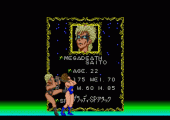
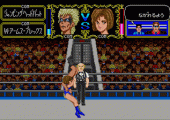
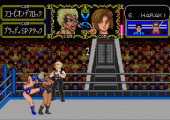
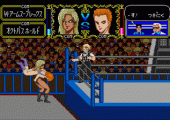
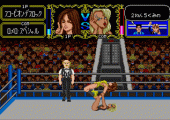
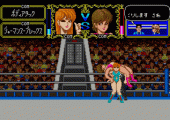
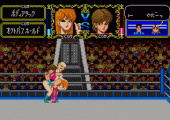
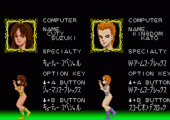
I remember beating this game without any effort at all.
I was using turbo button turned on so my character keep punching the enemies until they’re down, then approaching when they’re down with turbo turned on to do the wrestling move. Repeating this over and over until I won all the matches.